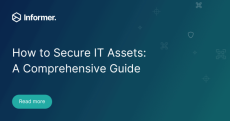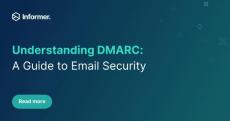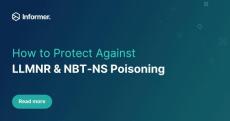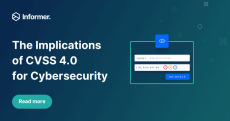|
By Marios Kyriacou
It is a proud and exciting day for me to announce that Bugcrowd has acquired Informer. On this momentous day, I can’t help but take a walk down memory lane, thinking about the past decade of hard work and innovation that led us to this moment. Ten years ago, I founded a specialist penetration testing business called The Security Bureau. As our client base grew, certain patterns emerged and it became clear that many organizations were unsure of exactly which assets were internet-facing.
|
By Alastair Digby
There’s a seemingly endless list of cybersecurity threats facing organisations today. Among these threats, typosquatting stands out as a deceptive practice used by threat actors to exploit user errors in typing website addresses. To combat this growing menace, asset discovery tools play a crucial role in identifying and mitigating the risks associated with malicious typosquatting domains.
|
By Alastair Digby
To effectively protect themselves from major threats and minimize cyber risks, organisations must fully understand their digital assets and systems. These could be targeted by unauthorised users looking to exploit weaknesses. However, gaining comprehensive visibility into all potential entry points in an attack surface is a significant challenge in today’s dynamic and distributed IT environments.
|
By Alastair Digby
The increase in cyberattacks increases year-on-year with attacks being more and more sophisticated. It’s a daunting task for security teams to adapt security strategies to proactively mitigate threats against the backdrop of a shortage of cybersecurity talent and budgets stretched. This is leading to organisations adopting proactive defence strategies using tools with continuous monitoring capabilities.
|
By Alastair Digby
In the age of attack surface expansion, securing IT assets is no longer optional—it’s a necessity. IT and cybersecurity leaders must protect their organisation’s digital assets from increasing cyber threats. Cybersecurity Ventures predicts that cybercrime will cost the world $10.5 trillion annually by 2025, according to their report. This underscores the importance of having a robust security strategy in place.
|
By Elise Imison
In this comprehensive guide, we will delve into the world of DMARC (Domain-based Message Authentication, Reporting, and Conformance) and explore how it enhances email security, protects against phishing attacks, and ensures the authenticity of emails. As a leading expert in cybersecurity, we will provide you with valuable insights and detailed information on how DMARC works, its benefits, implementation steps, and best practices.
|
By Elise Imison
Active Directory (AD) is a critical component of many organizations’ IT infrastructure. It provides a centralized repository for user and computer accounts, as well as a variety of other services. As a result, AD is a common target for attackers and there has been no shortage of AD attacks in the headlines. In this blog post, we will dive into the depths of LLMNR and NBT-NS poisoning, understanding their mechanisms, implications, and ways to mitigate the risks they pose.
|
By Marios Kyriacou
In today’s interconnected world, organizations face numerous threats from external attackers aiming to exploit vulnerabilities in their systems. Understanding how to prioritize risks in the external attack surface is crucial for mitigating potential vulnerabilities and safeguarding sensitive data. In this comprehensive guide, we will delve into the key considerations and best practices to help you effectively prioritize and manage risks in your organization’s external attack surface.
|
By Alastair Digby
Infosec teams rely on metrics and frameworks to prioritize vulnerabilities and understand their potential impact as part of their vulnerability management programs. These metrics are crucial for organizations to assess the impact of any vulnerabilities identified during any type of vulnerability assessment. One such framework widely used by penetration testing organizations and security tools is the Common Vulnerability Scoring System (CVSS).
|
By Elise Imison
A subdomain is a prefix added to a domain name to separate a section of your website. It’s a part of the Domain Name System (DNS) hierarchy and is a domain that is a part of another (main) domain. Subdomains are primarily used to manage extensive sections of a web application that require their own content hierarchy, such as online stores, blogs, job boards, or support platforms.
- May 2024 (2)
- February 2024 (3)
- August 2023 (1)
- July 2023 (1)
- June 2023 (3)
- February 2023 (1)
- January 2023 (1)
- December 2022 (2)
- November 2022 (1)
Informer's External Attack Surface Management (EASM) and Pen Testing platform help CISOs, CTOs and IT teams map external assets and identify vulnerabilities in real time so they can be remediated before attackers can exploit them.
We help CISOs, CTOs, and IT leaders manage their external attack surface by combining asset discovery, vulnerability scanning and actionable remediation insights to reduce cyber risk.
External Attack Surface Management Platform:
- Asset Discovery And Inventory: Keep track of the internet-facing assets that make up your external attack surface with an accurate asset inventory.
- Cloud Asset Monitoring: Monitor your cloud accounts in real-time and receive alerts for any configuration errors or potential security risks.
- Attack Surface Reduction: Identify vulnerabilities and security risks hiding within digital assets as your attack surface expands.
- Risk Validation: Identify, analyze, and evaluate the risks affecting your organization's assets with a manual security assessment.
Combining the power of automation and manual security testing we help our clients continuously map their attack surface, manage vulnerabilities, and remediate faster.










